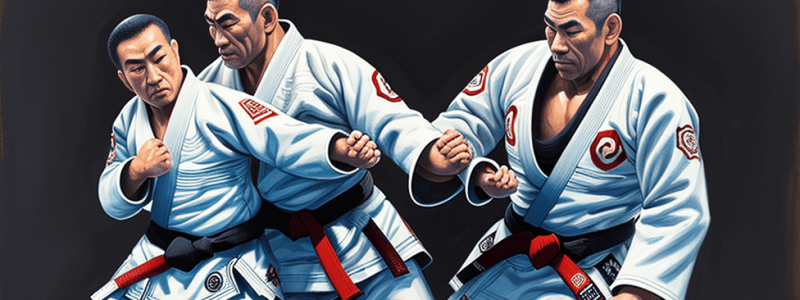Podcast
Questions and Answers
Where is it believed that systemized martial arts techniques came from along with Buddhism?
Where is it believed that systemized martial arts techniques came from along with Buddhism?
- China
- Japan
- India (correct)
- Korea
What did Jigoro Kano develop in the late 1800s?
What did Jigoro Kano develop in the late 1800s?
- A system of kung fu
- A type of taekwondo
- His own version of jiu-jitsu, called judo (correct)
- A new form of karate
What was the reason for developing an empty hand system of self-defense by Buddhist Monks in northern India?
What was the reason for developing an empty hand system of self-defense by Buddhist Monks in northern India?
- To create a new form of meditation
- To challenge the local warriors
- Buddhist religious and moral values did not encourage the use of weapons (correct)
- To impress the local community
What was the main reason for the development and practice of jiu-jitsu in Japan between the 8th and 16th centuries?
What was the main reason for the development and practice of jiu-jitsu in Japan between the 8th and 16th centuries?
Who introduced Japanese Jiu-Jitsu to the Gracie family in Brazil around 1914?
Who introduced Japanese Jiu-Jitsu to the Gracie family in Brazil around 1914?
Who was initially advised against practicing jiu-jitsu due to health issues?
Who was initially advised against practicing jiu-jitsu due to health issues?
Who fought 21 times, with notable victories and legendary performances in defeat?
Who fought 21 times, with notable victories and legendary performances in defeat?
When was the Ultimate Fighting Championship (UFC) born?
When was the Ultimate Fighting Championship (UFC) born?
Who moved to the United States in 1978 to share jiu-jitsu?
Who moved to the United States in 1978 to share jiu-jitsu?
Who won three of the first four tournaments of the Ultimate Fighting Championship (UFC)?
Who won three of the first four tournaments of the Ultimate Fighting Championship (UFC)?
When was Gracie Survival Tactics (GST) developed for law enforcement professionals?
When was Gracie Survival Tactics (GST) developed for law enforcement professionals?
When did the Gracie Academy transition to Gracie University?
When did the Gracie Academy transition to Gracie University?
Who is credited with developing judo as a safer way to practice jiu-jitsu?
Who is credited with developing judo as a safer way to practice jiu-jitsu?
After which period was jiu-jitsu no longer needed on the battlefield in Japan?
After which period was jiu-jitsu no longer needed on the battlefield in Japan?
Where is it believed that systemized martial arts techniques, along with Buddhism, originated?
Where is it believed that systemized martial arts techniques, along with Buddhism, originated?
Who is credited with altering and preserving the realistic effectiveness of jiu-jitsu in the form of judo?
Who is credited with altering and preserving the realistic effectiveness of jiu-jitsu in the form of judo?
What did Helio Gracie emphasize in the development of Gracie Jiu-Jitsu?
What did Helio Gracie emphasize in the development of Gracie Jiu-Jitsu?
Who set the world record for the longest uninterrupted no-holds-barred fight in history?
Who set the world record for the longest uninterrupted no-holds-barred fight in history?
When did Rorion Gracie establish the first Gracie Academy outside of Brazil?
When did Rorion Gracie establish the first Gracie Academy outside of Brazil?
What event showcased the effectiveness of Gracie Jiu-Jitsu?
What event showcased the effectiveness of Gracie Jiu-Jitsu?
What did Mitsuyo Maeda introduce to the Gracie family in Brazil around 1914?
What did Mitsuyo Maeda introduce to the Gracie family in Brazil around 1914?
Who won the first UFC tournaments, showcasing the effectiveness of Gracie Jiu-Jitsu?
Who won the first UFC tournaments, showcasing the effectiveness of Gracie Jiu-Jitsu?
Who was a direct student of Kano and taught traditional Japanese Jiu-Jitsu to Carlos Gracie?
Who was a direct student of Kano and taught traditional Japanese Jiu-Jitsu to Carlos Gracie?
When did the Gracies introduce Gracie Jiu-Jitsu to the US Army Special Forces?
When did the Gracies introduce Gracie Jiu-Jitsu to the US Army Special Forces?
When did the Gracie Academy introduce Gracie University online?
When did the Gracie Academy introduce Gracie University online?
Who moved to the United States in 1978 to share jiu-jitsu?
Who moved to the United States in 1978 to share jiu-jitsu?
What inspired the armlock technique known as the Kimura?
What inspired the armlock technique known as the Kimura?
Study Notes
History and Impact of Gracie Jiu-Jitsu
- Mitsuyo Maeda, also known as "Count Koma," introduced Japanese Jiu-Jitsu to the Gracie family in Brazil around 1914.
- Maeda, a direct student of Kano, taught traditional Japanese Jiu-Jitsu to Carlos Gracie, who then shared his knowledge with his brothers.
- Helio Gracie, initially advised against practicing jiu-jitsu due to health issues, began training in the 1920s, leading to the development of Gracie/Brazilian Jiu-Jitsu.
- Emphasizing leverage and timing over strength and speed, Helio modified techniques to create Gracie Jiu-Jitsu.
- Helio Gracie fought 21 times, with notable victories and legendary performances in defeat.
- In 1951, at 37, Helio defeated Yukio Kato and fought Masahiko Kimura, who won with the reverse ude-garami and inspired the armlock technique known as the Kimura.
- In 1955, at 41, Helio fought Waldemar Santana, setting the world record for the longest uninterrupted no-holds-barred fight in history.
- Rorion Gracie moved to the United States in 1978 to share jiu-jitsu, establishing the first Gracie Academy outside of Brazil in 1989.
- The Ultimate Fighting Championship (UFC) was born in 1993, with Royce Gracie winning three of the first four tournaments, showcasing the effectiveness of Gracie Jiu-Jitsu.
- The Gracies introduced Gracie Jiu-Jitsu to the US Army Special Forces in 1994, leading to the development of the Gracie Combatives program.
- In 1995, Gracie Survival Tactics (GST) was developed for law enforcement professionals, addressing close-quarters combat challenges.
- The Gracie Academy transitioned to Gracie University in 2009, offering the first web-based instructional program for Gracie Jiu-Jitsu.
History and Impact of Gracie Jiu-Jitsu
- Mitsuyo Maeda, also known as "Count Koma," introduced Japanese Jiu-Jitsu to the Gracie family in Brazil around 1914.
- Maeda, a direct student of Kano, taught traditional Japanese Jiu-Jitsu to Carlos Gracie, who then shared his knowledge with his brothers.
- Helio Gracie, initially advised against practicing jiu-jitsu due to health issues, began training in the 1920s, leading to the development of Gracie/Brazilian Jiu-Jitsu.
- Emphasizing leverage and timing over strength and speed, Helio modified techniques to create Gracie Jiu-Jitsu.
- Helio Gracie fought 21 times, with notable victories and legendary performances in defeat.
- In 1951, at 37, Helio defeated Yukio Kato and fought Masahiko Kimura, who won with the reverse ude-garami and inspired the armlock technique known as the Kimura.
- In 1955, at 41, Helio fought Waldemar Santana, setting the world record for the longest uninterrupted no-holds-barred fight in history.
- Rorion Gracie moved to the United States in 1978 to share jiu-jitsu, establishing the first Gracie Academy outside of Brazil in 1989.
- The Ultimate Fighting Championship (UFC) was born in 1993, with Royce Gracie winning three of the first four tournaments, showcasing the effectiveness of Gracie Jiu-Jitsu.
- The Gracies introduced Gracie Jiu-Jitsu to the US Army Special Forces in 1994, leading to the development of the Gracie Combatives program.
- In 1995, Gracie Survival Tactics (GST) was developed for law enforcement professionals, addressing close-quarters combat challenges.
- The Gracie Academy transitioned to Gracie University in 2009, offering the first web-based instructional program for Gracie Jiu-Jitsu.
History and Impact of Gracie Jiu-Jitsu
- Mitsuyo Maeda, also known as "Count Koma," introduced Japanese Jiu-Jitsu to the Gracie family in Brazil around 1914.
- Maeda, a direct student of Kano, taught traditional Japanese Jiu-Jitsu to Carlos Gracie, who then shared his knowledge with his brothers.
- Helio Gracie, initially advised against practicing jiu-jitsu due to health issues, began training in the 1920s, leading to the development of Gracie/Brazilian Jiu-Jitsu.
- Emphasizing leverage and timing over strength and speed, Helio modified techniques to create Gracie Jiu-Jitsu.
- Helio Gracie fought 21 times, with notable victories and legendary performances in defeat.
- In 1951, at 37, Helio defeated Yukio Kato and fought Masahiko Kimura, who won with the reverse ude-garami and inspired the armlock technique known as the Kimura.
- In 1955, at 41, Helio fought Waldemar Santana, setting the world record for the longest uninterrupted no-holds-barred fight in history.
- Rorion Gracie moved to the United States in 1978 to share jiu-jitsu, establishing the first Gracie Academy outside of Brazil in 1989.
- The Ultimate Fighting Championship (UFC) was born in 1993, with Royce Gracie winning three of the first four tournaments, showcasing the effectiveness of Gracie Jiu-Jitsu.
- The Gracies introduced Gracie Jiu-Jitsu to the US Army Special Forces in 1994, leading to the development of the Gracie Combatives program.
- In 1995, Gracie Survival Tactics (GST) was developed for law enforcement professionals, addressing close-quarters combat challenges.
- The Gracie Academy transitioned to Gracie University in 2009, offering the first web-based instructional program for Gracie Jiu-Jitsu.
Studying That Suits You
Use AI to generate personalized quizzes and flashcards to suit your learning preferences.




